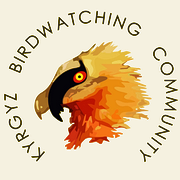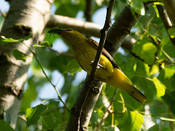search
classification
|
basic information
|
video
|
reports |
European Golden Oriole
Oriolus oriolus (Linnaeus, 1758)

|

|
|
|
2017-07-25
Chuy Valley, Leninskoe |
© Irina Romanovskaia
|
|
Description
The European Golden Oriole is some larger than Common Starling. The males has the bright-yellow background color, the black with yellowish spots wings and tail. The female most often has the yellowish-green upper parts, greenish-grey wings, and the yellowish-white with longitudinal strikes under parts. The females' coloring is very variable; some females look brightly as males. Juveniles are similar on females but have darker under parts. First year males also are similar on females but more yellow on the breast and abdomen, more contrast on tail. Weight 50-90 grams, length about 25, wing 14,5-16,1, wingspan about 45 cm.
Biology
In Kazakhstan the European Golden Oriole is common breeding migrant. It inhabits the deciduous flood plains and riparian forest, groves, gardens and old forest-belts on plains and in foothills up to 1500-2000 m. During migration it also occurs in the saxaul forests, bush thickets, juniper forests (up to 2700 m), isolated trees and rare in reed beds. It is one of the latest spring migrant. It appears onto “green” forests on late April – early May in southern parts of range, and till late May in northern ones. It migrates singly or in small groups. Pairs breed quite far one from another. Both parents build the nest on the branches fork (on poplar, birch, willow and very rarely on pine) on 10-15 meters. Bast-made nest is lined by thin grass. Clutches of 3-5 (more often of 4 eggs) are laid on mid May – mid June. For 13-15 days mainly female incubates, male feeds it and sometimes help it to incubate. Both parents feed juveniles, which fledge after 14-15 days, at the end of June – mid July. It eats the insects and spiders found mostly on trees' crowns, especially rather eats caterpillars, additional food is berries. Autumn migration begins in early August; birds fly out singly or in flocks of one-two dozen birds. The majority of the birds migrate on the end of August – early September. Latest migrants recorded in early October.
References
В.К.Рябицев. "Птицы Урала, Приуралья и Западной Сибири". Екатеринбург, Изд-во Уральского университета, 2000. Э.И.Гаврилов. "Фауна и распространение птиц Казахстана". Алматы, 1999. Gavrilov E. I., Gavrilov A. E. "The Birds of Kazakhstan". Almaty, 2005. А.Ф.Ковшарь "Певчие птицы". Алма-Ата, "Кайнар", 1983.











